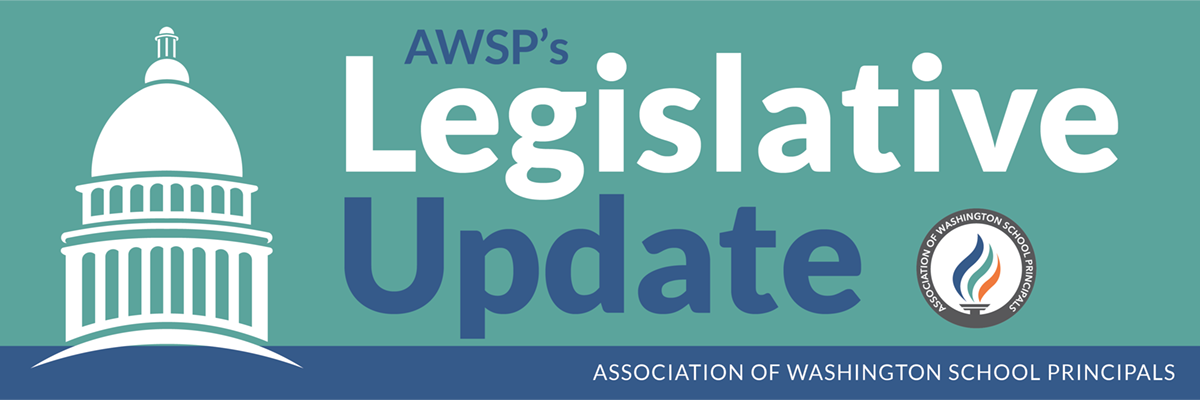
Budgets are Released and There's No Looking Back Now
 Pictured above: Drew Thompson from Colorado State University competes in high jump.
Pictured above: Drew Thompson from Colorado State University competes in high jump.
A collective “ugh” was felt by the education community this week at the Capitol as the House and Senate released their supplemental budgets. Education advocates remain concerned by inadequate funding and we are using several talking points from OSPI to help explain why districts are facing shortages. Here are a few of them:
Transition from ESSER
- On average, ESSER funds made up just 3-5% of a school district’s budget. These funds bought learning devices, connectivity, PPE, and kept our bus drivers and teachers employed during the pandemic to continue serving students as we adjusted to a new, remote learning environment.
- When you look at the net impact of ESSER funds, these temporary dollars only slightly offset the permanent state funds that our schools lost due to changes in student enrollment levels during the pandemic.
Overall K-12 Funding/Enrollment decline
- With ESSER going away, fewer permanent funds mean that some of our districts are making really difficult decisions about their budgets. This in itself is not new, because districts are used to engaging in budget reductions as enrollment fluctuates.
- However, due to the increasing inflation over the past few years, we are seeing worrisome trends in funding for our state’s paramount duty: our public schools.
- We can see that the share of the state’s budget that the legislature invests in schools has been in a downward trend since 2019, declining from 51% of the budget to now just 43%.
- We are grateful for the legislature’s investments in things like special education, counselors, nurses, and other support staff, however, while the actual dollar amounts provided by the legislature have increased, the buying power of those dollars has actually been decreasing since the 2019-20 school year.
- If you look at total K-12 spending (local and state) funding per student (taking into account all of the increased investments, the lower enrollment, and adjusted for inflation) we are actually investing $1,000 less per pupil than we were 5 years ago. This is equivalent to almost $1B in state resources. Yet, our systems are expected to provide the same, if not better, level of programming.
But, there’s no looking back. We have to press on and continue our advocacy efforts to push for adequate funding that meets our state’s “paramount duty” to fund public schools.
The Washington Research Council wrote a good overview comparing the House and Senate supplemental budgets that were released earlier in the week. Besides increases in maintenance level spending (for COLAs and some additional increases to the prototypical model for nurses, counselors, and social workers), here is a look at the major items of new spending from both sides.
House Budget
Special Education Enhancements ($32.3 million NGF-O 2023-25; $32.3 million Total 2023- 25; $114.9 million 4-year NGF-O) Funding is provided for an increase to the funded enrollment limit for students eligible for special education from 15 percent to 17.25 percent, as required in HB 2180. Additionally, funding is provided for cohorts of special education teacher residents to participate in training, coursework, and classroom co-teaching with mentor teachers.
Maintenance, Supplies, and Operating Costs ($43.4 million NGF-O 2023-25; $43.4 million Total 2023-25; $94.7 million 4-year NGF-O) Per pupil rates for maintenance, supplies, and operating costs (MSOCs) are increased by $21 beginning in the current 2023-24 school year, as required under HB 2494. The categories of MSOCs increased are utilities and insurance, instructional professional development, and security and central office.
Community Eligibility Provision ($41.2 million NGF-O 2023-25; $41.2 million Total 2023- 25; $90.4 million 4-year NGF-O) Funding is provided for additional reimbursements to schools participating in the Community Eligibility Provisions program for school meals not reimbursed at the federal free meal rate.
Transportation Actuals for 2023-24 ($76.9 million NGF-O 2023-25; $76.9 million Total 2023-25; $165.8 million 4-year NGF-O) Appropriations are increased to reflect updated 2023-24 school year transportation allocations calculated by OSPI in February of this year, which are above the estimated amounts assumed through January.
Senate Budget
Transportation Actuals – $76.9 million NGF-O (2023-25); $88.9 million NGF-O (2025-27) Funding is provided to account for OSPI allocation of transportation funding to school districts.
K-12 Staffing – $49.6 million NGF-O (2023-25); $129.8 million NGF-O (2025-27) Funding is provided to modify the prototypical school staffing model and to implement SB 5882 (prototypical school staffing) which increases staff allocations for paraeducators, office supports, and non instructional aides.
CEP Expansion – $45 million NGF-O (2023-25); $45 million NGF-O (2025-27) Funding is provided to reimburse additional school districts required to participate in the federal Community Eligibility Provision (CEP) pursuant to Chapter 7, Laws of 2022 (SHB 1878). The funding will support schools not eligible for the full federal reimbursement rate.
Transportation – $23.1 million NGF-O (2023-25); $25.6 million NGF-O (2025-27) Funding is provided for adequate and predictable student transportation as proposed in SB 5873. For McKinney-Vento homeless students, $400 per student is provided to 32,086 students. Funding is provided in the amount of $170,000 for OSPI to collect student expenditure data, $6 million is provided to the OSPI for supplemental transportation allocations, and $4 million is provided to OSPI to allow contract bus drivers and related staff to opt-in to benefits. Funding is provided to OSPI in the amount of $130,000 to implement SB 6031.
Special Education – $13.5 million NGF-O (2025-27); $36 million NGF-O (2025-27) Funding is provided to increase the 15 percent enrollment limit on state special education funding to 15.6 percent.
You can see that the biggest difference between the two budgets is that the House is prioritizing increased funding for MSOC and the Senate is prioritizing funding for increasing the prototypical funding model for paraeducators.
The House partly honored our request for additional funding for the principal intern grant program and added $223,000 to the current amount of $477,000. The Senate did not add additional funds for the grant. This was well short of the $1 million we requested be added. Neither side added funding to support current building principals so we continue to impress upon the legislature the critical nature of this request.
All of these differences will have to be resolved through budget negotiations in the next two weeks.
Take Action Now!
Please take action now and send an email to your legislators about increasing K-12 funding. This is an easy way to get the word out across our state that they must support our paramount duty. Click on the link above, and scroll down the page until you see the orange “Action Alert” on school funding. Enter your home or school address and then you’ll see a prewritten email that will go to your legislators. You can also add more information or anecdotes to this email if you’d like.
Bills
The restraint and isolation bill (HB 1479) failed to move out of the Senate Early Learning and K-12 Education Committee.
The computer science competency bill (SB 5849) and the financial literacy requirement for graduation bill (HB 1915) are both still alive. We continue working with other advocates to either amend these bills to direct the State Board of Education to review graduation requirements comprehensively or to not pass them this session.
Additional bills are still moving through the session, and those with a fiscal implication need to pass out of House Appropriations or Senate Ways and Means by Monday, February 26. After that, they must pass out of the opposite house by March 1. The session is scheduled to end on March 7.
Here is my complete bill tracking list if you’d like to check out all of the bills.
Engage in Advocacy
February is our “Member Engagement Month,” and there is no better way to engage with your professional association this month than by getting involved in our advocacy efforts. There are a variety of ways in which you can do this. Some take a few seconds, and some take a little more time. Choose your own level of engagement, but please do take action to support legislation that would help “Grow, Support, and Sustain” our current and future school leaders.
Send a Quick Action Alert
This is the easiest option of all. Here are links to three quick action alerts that will send an email to your legislators after you enter your own name and address. The first one is to ask that the Legislature commit additional available revenue projected in the February revenue forecast to help stabilize school district budgets and address the fiscal crisis facing our school districts. The next is to request support for a budget proviso that would add more funds to the principal intern grant and to provide regional support for current building leaders. The last one allows you to write your own message. Try these now…they are so easy! Scroll down the page until you see the Action Alert you would like to send.
Be a Principal Partner with a Legislator
If you would like to commit to communicating more regularly with your legislators, let me know. Email me if you would like to be a “Principal Partner with a Legislator”.
Invite Your Legislator to be the “Principal for a Day”
We had a very successful pilot project a few weeks ago when Senator Claire Wilson shadowed Principal Terrie Garrison at Fir Grove Elementary in Puyallup and when Representative Clyde Shavers shadowed Principal Jenny Hunt at Broad View Elementary in Oak Harbor. We plan to hold this event again in October, 2024. If you would like a legislator to shadow you next fall, send me an email.
Meet with Your Legislators
It’s really easy to set up meetings either in-person or via Zoom with your legislators. They should prioritize meeting with you because you are their local constituents. Here is a link for their contact information and it’s also helpful to include their legislative assistants in your email to request a meeting. It’s possible to meet with them now during the legislative session, but it will probably be a short 15-minute conversation. During the interim, they should have more time to meet with you. Either option works because it’s all about developing a working relationship with our policymakers.
Participate on our Advocacy Advisory Council
We have over 50 principals and assistant principals who belong to our AWSP Advocacy Advisory Council. During the legislative session, we meet weekly on Zoom to discuss the bills being heard that week and to strategize about how we, as an association, will respond. This group of people is invited to attend our annual “AWSP Day on the Hill” which will be held on Monday, February 5th. During the interim, we meet occasionally via Zoom to stay in touch about various issues, meet with legislators about bills that they are considering, and develop our legislative platform. Email me to get involved at this level.
Below are additional links to find out more about these bills and to contact your own legislators. Legislators care very much about hearing directly from their constituents. When we weigh in as an association, it is helpful and important, but having many of you reach out directly with a short email to legislators can be much more powerful.
Important Links:
Get Involved
Many thanks for all that you do for students and staff.
Please reach out if you have questions or comments. Thank you!
